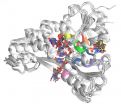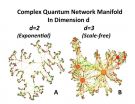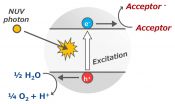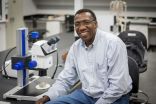(Press-News.org) Researchers at EMBL's European Bioinformatics Institute (EMBL-EBI) have developed a new method for studying the targets and effects of cancer drugs using data from discovery mass spectrometry (MS) experiments. The study is published in Nature Communications.
Understanding the biological signaling pathways that regulate metabolism and gene expression is challenging, because so many things are happening at once. But this understanding is crucial for knowing how a drug will affect healthy and cancer cells. Protein kinases play a pivotal role in these pathways by turning certain proteins on and off in a process called phosphorylation - and because such pathways are often deregulated in cancer, kinase inhibitors are used as treatments.
To create models of signaling pathways and networks, the researchers used data from 'discovery mass spectrometry (MS) phospho-proteomics', a tool for studying the phosphorylation of thousands of proteins expressed by a cell at a certain time. Such models could be used to test the potential effect of a drug computationally.
"MS is a very powerful tool because it lets you look at activities like phosphorylation in a huge number of proteins at once," says Julio Saez-Rodriguez, visiting group leader at EMBL-EBI. "But the data is typically very noisy, and random in terms of which of the tens of thousands of proteins in the cells it measures. It's a little like trying to make a London tube map based on random CCTV photos."
Until now, methods using MS phospho-proteomics data have put researchers on the right track in a general sense, for example pointing to groups of kinases that are likely to be active in a sample. The new method reconstructs pathways robustly, allowing researchers to ask more precise questions about how drugs affect proteins and pathways.
"Our method takes the noisy data from MS experiment, which is this large network with many interconnected cascades of kinase activities, filters the noise, and integrates the data. This is done entirely in the context of what we know about kinases and their substrates, so you can see how things are connected," explains Camille Terfve, an EMBL International PhD student in Julio's lab. "Then you can compare what happens with the signal, for example if you use one kind of inhibitor or another. So, it can show what the drug is really doing to the system, beyond the direction you initially believed it would take."
Thanks to a collaboration with the Cutillas lab at the Barts Cancer Institute, Queen Mary University of London, the researchers were able to use data from experiments using kinase inhibitors on breast cancer cells to demonstrate the method.
"There is a lot of knowledge out there about protein kinases and how they influence phosphorylation, and we've put this together with the enormous potential of MS to create and test logic models that provide a clear path for research," says Julio. "MS produces so much data that's very difficult to sift through - now, we can start to see the forest for the trees, and define which information is really important."
"It's really exciting to have found a way to make better use of MS data, and to use bioinformatics to make cancer research more efficient," adds Camille.
INFORMATION:
This work was supported by the EMBL International PhD Programme, Barts Charity and Cancer Research UK.
Source article: Terfve FN, et al. (2015). Large-scale models of signal propagation in human cells derived from discovery phosphoproteomic data. Nature Communications (in press). Published online 10 September; DOI: 10.1038/ncomms9033
NS3 is an enzyme specific to the hepatitis C virus. If developed, a drug capable of recognizing and selectively attacking it could fight the disease without side effects for the body. However, to be able to develop one we need to know more about the behavior of this important protein in the virus replication process. Some SISSA scientists have provided a detailed and comprehensive view of the behavior of NS3. The study has been published in the journal Nucleic Acids Research.
According to the WHO, a good 140 million people are affected by hepatitis C (3/4 million new cases ...
While sexual contact is not the most efficient means of hepatitis C (HCV) transmission, there have been several reports of outbreaks of sexually transmitted HCV in HIV-positive men who have sex with men (MSM). HCV infections are more likely to become persistent and to lead to progressive liver disease in people who are HIV-infected, even if they are receiving HIV treatment. Factors underlying these infections in HIV-positive MSM are only partially understood.
Researchers at NYU's Center for Drug Use and HIV Research (CDUHR) at the College of Nursing (NYUCN) have conducted ...
Future computers will require a magnetic material which can be manipulated ultra-rapidly by breaking the strong magnetic coupling. A study has been published in Nature Communications today in which Swedish and German scientists demonstrate that even the strongest magnetic coupling may be broken within picoseconds (10-12 s). This will open up an exciting new area of research.
The element gadolinium is named after the Uppsala chemist Johan Gadolin who discovered the first rare-earth metal yttrium in the late 1700s. Gadolinium is in the same class of elements and it has ...
Dublin, Thursday September 10th, 2015 - Scientists from Trinity College Dublin have discovered that one gene mutation in a single species can trigger dramatic changes in whole biological communities; changes can be as great as those caused by the extinction of a top predator.
By using bacteria to replicate ecological systems in the lab, they found that mutations of a single gene that alter how one bacterial species interacts with others had huge structural impacts across their multi-species microbial communities. These 'social mutants' varied in their ability to produce ...
Mathematicians investigating one of science's great questions -- how to unite the physics of the very big with that of the very small -- have discovered that when the understanding of complex networks such as the brain or the Internet is applied to geometry the results match up with quantum behavior.
The findings, published today (Thursday) in Scientific Reports, by researchers from Queen Mary University of London and Karlsruhe Institute of Technology, could explain one of the great problems in modern physics.
Currently ideas of gravity, developed by Einstein and Newton, ...
This news release is available in Japanese.
The Earth's atmosphere contains oxygen because plants continuously produce it through photosynthesis. This abundant supply of oxygen allows life forms like animals to flourish. Therefore, oxygen had been thought to be an essential biomarker for life on extrasolar planets. But now, a research assistant professor Norio Narita of the Astrobiology Center of National Institutes of Natural Sciences (NINS), which was founded in April 2015, and an associate professor Shigeyuki Masaoka, of the Institute of Molecular Science of NINS, ...
DENVER (Sept. 10, 2015) - An international team of scientists, including one from the University of Colorado Denver and another from the University of Colorado Anschutz Medical Campus in Aurora, announced the discovery Thursday of a new species of hominin, a small creature with a tiny brain that opens the door to a new way of thinking about our ancient ancestors.
The discovery of 15 individuals, consisting of 1,550 bones, represents the largest fossil hominin find on the African continent.
"We found adults and children in the cave who are members of genus Homo but ...
A new study conducted in collaboration with Facebook using anonymised data from the social networking site shows a correlation between people's social and financial status, and the levels of internationalism in their friendship networks - with those from higher social classes around the world having fewer friends outside of their own country.
Despite the fact that, arguably, people from higher social classes should be better positioned to travel and meet people from different countries, researchers found that, when it comes to friendship networks, people from those ...
ATLANTA -September 10, 2015- A new study finds breast cancer incidence and death rates are increasing in several low and middle income countries, even as death rates have declined in most high income countries, despite increasing or stable incidence rates. The findings come from a new report examining global patterns and trends in breast cancer using the most up-to-date cancer registry-based data available. It appears early online in Cancer Epidemiology Biomarkers and Prevention.
Breast cancer is the most commonly diagnosed cancer among all women worldwide overall and ...
Mothers who quit smoking in pregnancy are more likely to light-up again after their baby is born if they feel stressed - according to a new report from the University of East Anglia.
Researchers studied interviews with more than 1,000 new mothers and found that the stress of caring for a newborn, sleepless nights, social pressure, and the idea that they no longer need to protect the baby - all contribute to relapse.
The study also found that women who felt they were being supported by a partner were less likely to start smoking again.
Lead researcher Dr Caitlin Notley, ...




